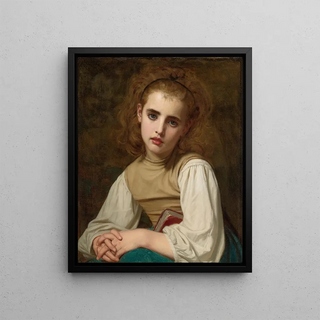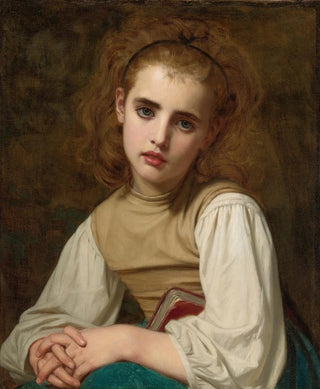Art print | Young beauty - Hugues Merle


View from behind

Frame (optional)
In the fascinating world of 19th-century painting, the art print "Young Beauty" by Hugues Merle stands out for its delicacy and emotional depth. This canvas, emblematic of the academic movement, invites attentive contemplation. It depicts a young woman whose gaze, both dreamy and contemplative, seems to capture a timeless essence of feminine beauty. Light plays a crucial role, caressing the contours of her face and hair, creating an atmosphere that is both intimate and universal. Immersing oneself in this work transports the viewer to a world where beauty and melancholy meet, revealing emotions that still resonate today.
Style and uniqueness of the art print
Hugues Merle's style is characterized by impressive technical mastery, combined with rare artistic sensitivity. In "Young Beauty," the meticulous details of the facial features and the finesse of the drapery demonstrate unparalleled craftsmanship. The colors, soft and harmonious, help create a serene, almost dreamlike ambiance. The choice of pose and the model's expression also reveal the artist's intention to capture a pure essence of femininity. Merle does not merely depict a figure; he succeeds in evoking a story, an emotion, and an atmosphere filled with subtlety. This art print, through its approach that is both realistic and poetic, invites reflection on fleeting beauty and the ephemeral nature of time.
The artist and his influence
Hugues Merle, born in 1823, managed to establish himself in the artistic landscape of his time thanks to his distinctive style and his ability to transcend conventions. A student of the Academy of Fine Arts, he was influenced by the great masters of classical painting while developing a personal approach that is uniquely his own. His works, often centered on themes of youth and beauty, testify to a particular sensitivity towards human emotions. Merle also contributed to redefining the female portrait, emphasizing not only outward appearance but also the inner depth of his models. His influence endures, inspiring

Matte finish

View from behind

Frame (optional)
In the fascinating world of 19th-century painting, the art print "Young Beauty" by Hugues Merle stands out for its delicacy and emotional depth. This canvas, emblematic of the academic movement, invites attentive contemplation. It depicts a young woman whose gaze, both dreamy and contemplative, seems to capture a timeless essence of feminine beauty. Light plays a crucial role, caressing the contours of her face and hair, creating an atmosphere that is both intimate and universal. Immersing oneself in this work transports the viewer to a world where beauty and melancholy meet, revealing emotions that still resonate today.
Style and uniqueness of the art print
Hugues Merle's style is characterized by impressive technical mastery, combined with rare artistic sensitivity. In "Young Beauty," the meticulous details of the facial features and the finesse of the drapery demonstrate unparalleled craftsmanship. The colors, soft and harmonious, help create a serene, almost dreamlike ambiance. The choice of pose and the model's expression also reveal the artist's intention to capture a pure essence of femininity. Merle does not merely depict a figure; he succeeds in evoking a story, an emotion, and an atmosphere filled with subtlety. This art print, through its approach that is both realistic and poetic, invites reflection on fleeting beauty and the ephemeral nature of time.
The artist and his influence
Hugues Merle, born in 1823, managed to establish himself in the artistic landscape of his time thanks to his distinctive style and his ability to transcend conventions. A student of the Academy of Fine Arts, he was influenced by the great masters of classical painting while developing a personal approach that is uniquely his own. His works, often centered on themes of youth and beauty, testify to a particular sensitivity towards human emotions. Merle also contributed to redefining the female portrait, emphasizing not only outward appearance but also the inner depth of his models. His influence endures, inspiring






